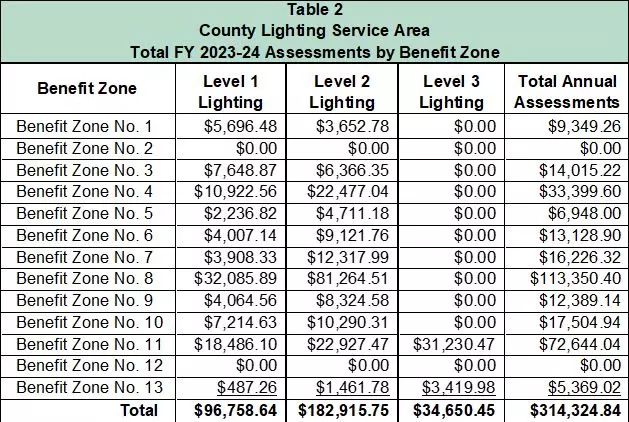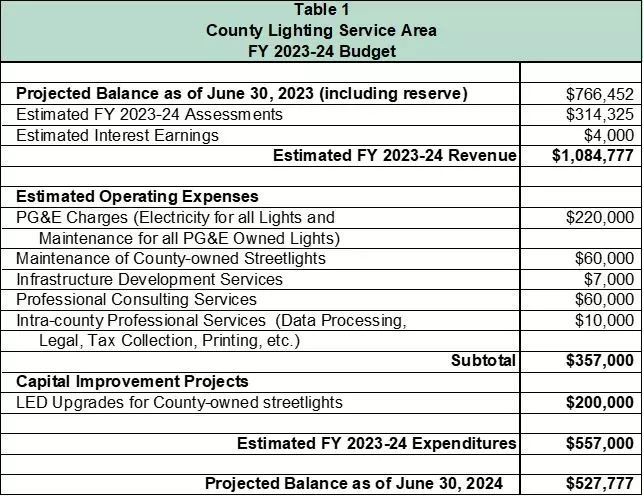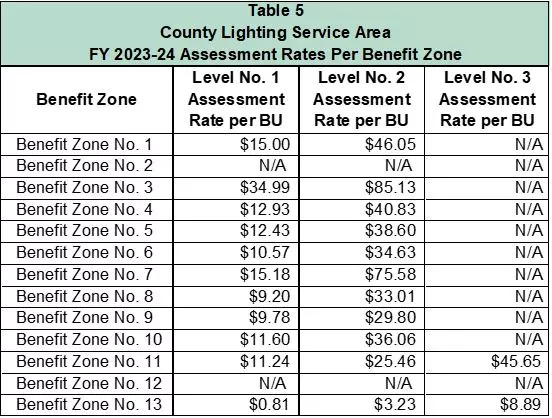Request new street light installation
County lighting service area (FAQs)
Last updated: 11/09/2023 - 15:11
The assessment rates may be increased each fiscal year based on the prior year’s change in the Consumer Price Index (CPI) – Urban Wage Earners and Clerical Workers for the San Francisco/Oakland/San Jose area not to exceed three percent (3%). Although the maximum assessment rates may be increased each year, the County may use discretion as to whether or not to apply that allowable increase. Last year’s increase in CPI was 4.63% as calculated from December 31, 2021, through December 31, 2022, and the County increased assessment rates by 3% to keep up with inflationary maintenance cost increases and to fund future capital improvement projects.
To report a problem with a street light in your area, you must first identify who is responsible for the street light and be able to provide the light identification or badge number to the responsible party. To obtain this information, you may navigate to the street light using the CLSA Location Map and click on the defective light. An information box will appear with the appropriate contact number and website to report the problem. If the street light does not appear on the map, it is most likely owned and maintained by the City within Santa Clara County where the street light is located.
As an alternative method, to report a problem with a County-maintained street light, you can complete the Street Light Service Request form. If the street light is located within an adjacent City, please contact the appropriate City directly to report problems with their street lights.
When reporting a County-maintained street light problem, first check the pole for a maintenance logo. Most County-maintained street light poles, except wooden poles, have a maintenance logo attached to the pole on the street side, about 6 feet above the ground. A pole number is similarly located and consists of 4 or 5 digits. Wood poles do not have the logo but should have a pole number. If the pole number includes a letter as the 2nd or 3rd character, i.e., 1J11 or 12Q112, then it is most likely maintained by the City of San Jose's Department of Transportation. If the street light is on a wooden pole, then it might be maintained by Pacific Gas & Electric (PG&E). Report the outage directly to PG&E by using the link PG&E Street Light Service Request. The PG&E site can help identify whether the pole is maintained by PG&E or by a particular city, including contact information.
County traffic signal and roadway service requests submitted by one of the forms above will be responded to as soon as possible, often by the next business day; street light service requests are usually completed within 10 business days. Please contact other Agencies directly regarding problems with their facilities.
If you would like to request the installation of a new street light, please contact the County’s Consultant, Francisco & Associates, at (800) 441-8280. The typical process for the installation of a new street light lamp on an existing PG&E pole is as follows:
- Property owner calls Francisco & Associates to request the installation of a new street light.
- Francisco & Associates provides County with a location map and listing of affected property owners for County approval to proceed.
- Upon County approval, a Notice of Intent is sent to all affected property owners informing them of the proposed new street light installation. Affected property owners are given approximately one month to call and voice any questions or concerns.
- Assuming there is no objection to the proposed new street light lamp, Francisco & Associates submits an application on behalf of the County to PG&E for installation of the new street light.
- PG&E reviews the application and determines whether the project is feasible. If so, PG&E proceeds with and completes the installation.
Installing a new street light lamp on an existing PG&E pole would be at no cost to the property owners (paid for by PG&E). However, if there are no existing PG&E poles, or the existing PG&E poles are in an undesirable location to provide the proper level of street lighting, benefitting property owners would be required to pay the upfront cost of installing the new street light pole.
Table 3 below shows the total number of street lights being operated and maintained within each benefit zone for FY 2023-24.

Table 2 below shows the total annual assessment revenue generated by benefit zone for FY 2023-24.

To determine if your property is located within the boundaries of the CLSA Assessment District and charged for street lighting click on the following link CLSA Location Map and follow the instructions.
Upgrading to more energy-efficient lighting can yield cost savings to the County and property owners in both energy and maintenance costs. Approximately 80% of the CLSA street lights are owned and maintained by PG&E and the remaining 20% of the street lights are owned by the County of Santa Clara.
The street lights owned by PG&E were upgraded to LED in late 2016. County staff anticipates proceeding with the upgrade of the remaining 20% of CLSA street lights that are owned by the County during this fiscal year.
Table 1 below shows the fund balances, annual assessment revenue and proposed expenditures for FY 2023-24.

Installing a new street light on an existing PG&E pole would be at no cost to the property owners (paid for by PG&E). However, if there are no existing PG&E poles, or the existing PG&E poles are in an undesirable location to provide the proper level of street lighting, the property owners would be required to pay the cost of installing the new street light pole. Before PG&E can give property owners a cost estimate for installing a new street light pole they would need to know the location of the street light and conduct a field audit. Once the cost is known the County would want the affected property owners to sign a County prepared petition to show there is adequate property owner support to pay for the construction of the street light and annex the parcels into the CLSA. Depending on the complexity of the situation the County may also require a property owner meeting to discuss the process to annex into the CLSA. Regardless of whether there is an existing street light pole or not, property owners would also be responsible to pay for the annual cost to operate and maintain the new street light.
The CLSA Assessment District was formed under County Service Area Law as a means to provide funding for the annual cost to operate and maintain the street lighting system within the unincorporated pocket areas of Santa Clara County. In 2000, the County conducted a property owner election to form the CLSA Assessment District. Property owners who benefitted from the street lighting system were sent a notice describing the proposed assessment and a ballot to vote on forming the assessment district. The CLSA Assessment District was divided up into 13 benefit zones because each benefit zone (pocket area) had varying degrees of street lighting. Property owners located within 12 of the 13 benefit zones approved the formation of the CLSA Assessment District and subsequent levying of annual assessments. In 2010, the City of San Jose annexed one of the benefit zones into their City; therefore the CLSA Assessment District is now comprised of only 11 benefit zones.
Table 5 below shows the annual assessment rates by benefit zone and level of service for a single family residential parcel for FY 2023-24. Because there are varying degrees of existing street lighting within each benefit zone, three (3) separate and distinct levels of service have been created. Level of Service No. 1 includes all parcels that receive special benefit from intersection and cul-de-sac street lighting only. Level of Service No. 2 includes all parcels that receive special benefit from intersection, cul-de-sac and mid-block street lighting (street light spaced approximately 300 to 500 ft. apart along a street). Level of Service No. 3 includes all parcels that receive special benefit from intersection, cul-de-sac, mid-block and mid-mid block street lighting (street light spaced less than 300 ft. apart along a street).

Other land uses are assessed as follows:
- Condominium Parcels are assessed at 75% the rate of a single-family residential parcel due to the reduced population density per parcel and the reduced size of structure relative to the typical single-family residence. Condominium parcels are defined as parcels that have a land use classification as condominium or townhouse with the Santa Clara County Assessor’s Office.
- Multi-Family Parcels are assessed at 50% the rate of a single-family residential parcel per unit due to the reduced population density per multi-family unit and the reduced size of structure relative to the typical single-family residence. Multi-family parcels are defined as parcels that have a land use classification as multi-family, which includes duplexes, triplexes, apartments, and co-ops with the Santa Clara County Assessor’s Office.
- Commercial, Industrial, Institutional, Public, Quasi Public, Non-Manufacturing and Manufacturing Parcels are assessed at 6 times the rate of a single-family residential parcel per acre of land. The average number of single-family residential parcels per acre within the boundaries of the County Lighting Service Area Assessment District is estimated to be 6.00 single-family residential parcels per acre. Therefore, in order to equate non-residential property to that of a single-family residential parcel, all commercial, industrial, institutional, public, quasi-public and manufacturing parcels are assessed 6 times the rate of a single-family residential parcel per acre of land with a minimum assessment equal to the single-family parcel rate.
- All undeveloped parcels that have no improvements constructed thereon and have a land use classification as vacant with the Santa Clara County Assessor’s Office or agricultural parcels without a structure constructed on it are assessed at 50% of the single-family rate per parcel. Undeveloped parcels receive a reduced benefit from street lighting because they generate less pedestrian and vehicular traffic, however they still benefit from having existing street lighting in place in the event they were to develop.
To review a copy of the FY 2023-24 CLSA Report which provides more detailed information about the CLSA Assessment District and Assessment Methodology click:
The CLSA Assessment District, through the levy of assessments, pays for the annual cost to operate, maintain and service the street lighting system located within the 11 benefit zones. The street lighting system includes, but is not limited to, poles, fixtures, bulbs, conduits, guys, anchors, posts, pedestals, metering devices and any other appurtenant improvements needed to provide street lighting within the boundaries of the CLSA Assessment District.
Please contact the County of Santa Clara Roads and Airports Department at (408) 573-2400 or the County’s Consultant, Francisco & Associates at (800)-441-8280.
The CLSA is a dependent special district formed under the authority of the County of Santa Clara and governed by the County Board of Supervisors. The annual operations and management of the CLSA is performed by the County’s Roads & Airports Department. Among other things, this department is responsible for the operation and maintenance of the expressways and rural and urban roadways in the unincorporated areas of the County which includes over 4,500 street lights.